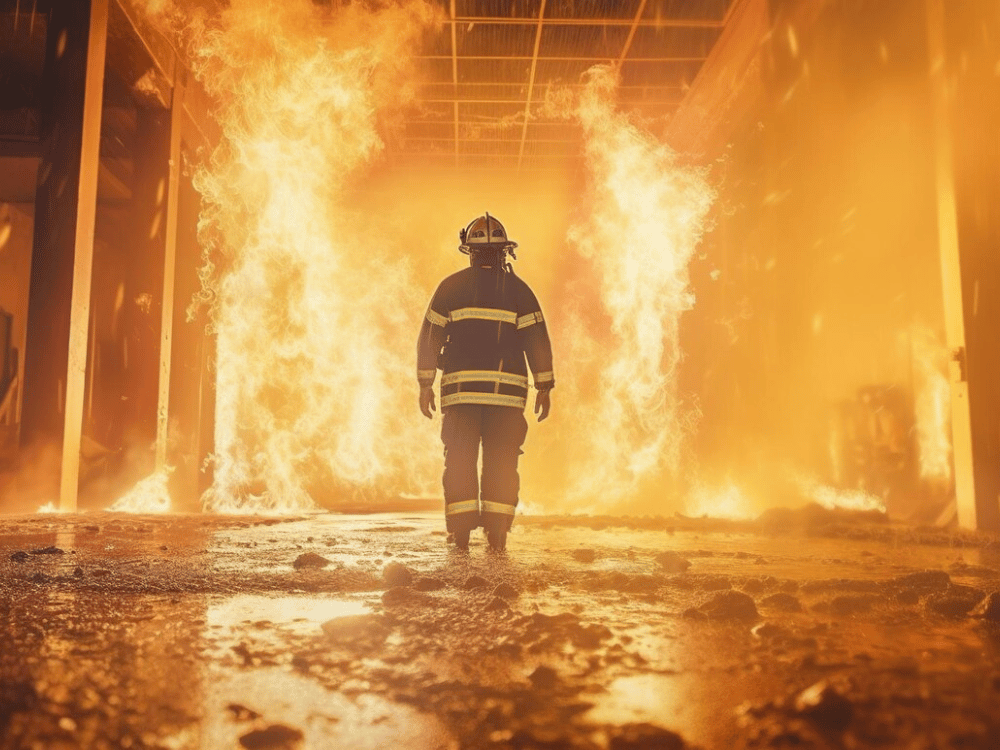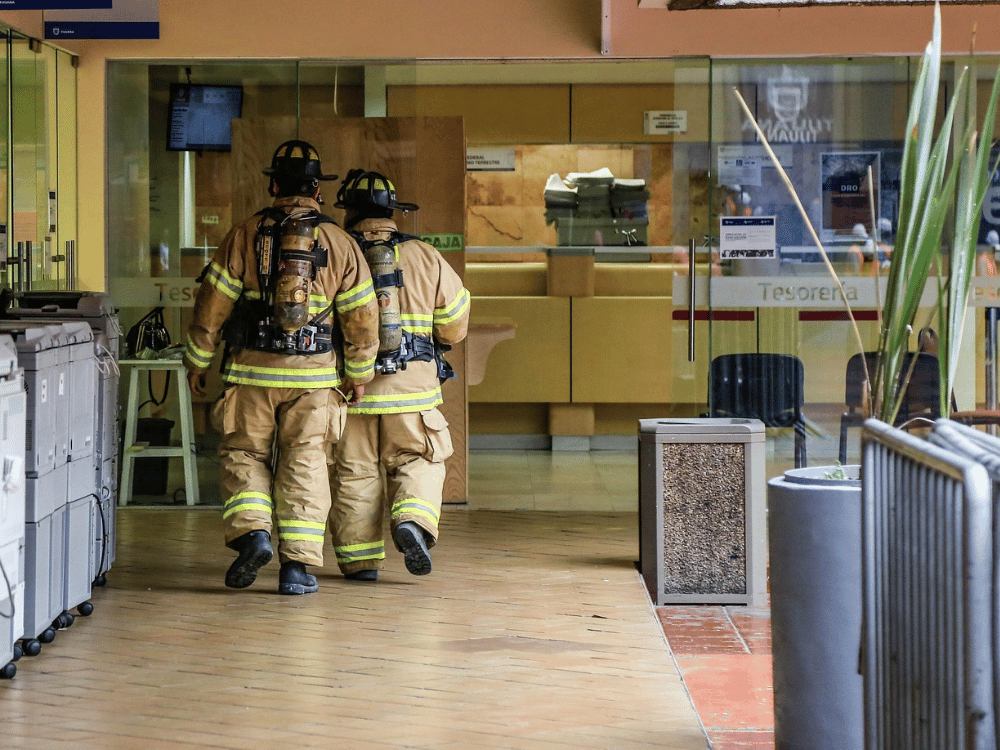Over the last 5 years, Fire and Rescue Services in the UK were called out to over 39,000 blazes in non-domestic settings.
These statistics demonstrate how prevalent workplace fires can be. In addition, they also highlight the importance of giving your team appropriate fire safety coaching with TSW Training.
Knowing the potential causes of fire and educating your team on hazard perception can be invaluable to keeping your employees and property safe.
In this blog, we’ll cover fire prevention at the source of ignition by highlighting various ways a blaze can take hold. Because when you know how a fire starts, it becomes easier to avoid it.
How to Describe a Potential Ignition Source in Your Workplace
Potential fire ignition sources are anything that can cause an explosion or fire to occur.
More specifically, the Health and Safety Executive (HSE) describes potential ignition sources in the workplace as things like electrical sparks, static electricity, naked flames, hot surfaces, impact, friction, etc.
Other ignition source examples are:
- Mechanical sparks
- Heat of compression
- Radiated heat, e.g., microwaves
- Portable and fixed heaters
- Chemical reactions
- Flames (including smoking or boilers etc.)
Is a Potential Ignition Source a Risk or a Hazard?
Regarding fire risk assessments, potential ignition sources are seen as hazards. Fire hazards are defined as anything in your workplace that may cause a fire.
Alternatively, on a wider point of hazards vs. risks, risks are defined as a combination of a hazard’s potential to occur and the severity of its circumstances.
These definitions are present in both fire and standard risk assessment processes.
3 Things Needed to Start a Fire
While it is true that anything that burns is potential fuel for a fire, there are 3 core elements required to ignite a blaze.
Known as the “triangle of fire,” the 3 things needed to start a fire are:
- Oxygen
- Heat
- Fuel
However, further research has suggested that the triangle of fire should be altered to become a fire tetrahedron. The change accommodates a fourth combustion element – a chain chemical reaction.
The theory suggests that the fire will be extinguished if you remove any of these four elements.
Common Types of Potential Ignition Sources
We know that a source of ignition in the workplace is anything capable of producing enough heat to start a blaze.
But, as we have touched on previously, there are different kinds of potential ignition sources around your premises.
These are generally collated into four main categories:
- Electrical
- Mechanical
- Chemical
- Thermal
Electrical Ignition Sources
Things like overloaded sockets are a potential fire risk. But what other electrical ignition sources are there?
- Electric motors
- Electric heaters
- Switches
- Electrical faults
- Lighting
- Sparks
- Static electricity
- Electric cooking equipment
Mechanical Ignition Sources
Mechanical equipment is one of the most common ignition sources in the workplace, especially in more industrial settings like construction sites, manufacturing plants or automotive garages.
Examples of mechanical ignition sources include instances of excessive friction or overheating machinery and tools.
However, the improper use of machinery can also cause potentially hazardous situations through additional strain, friction and motor shorting.
Chemical Ignition Sources
Dangerous chemicals can also be a potential source of ignition. Flammable liquids and combustible gases are both incredibly potent fire starters.
Locations like garages, laboratories, and petrol stations (for example) will have an abundance of hazardous chemicals to keep away from ignition sources.
That’s why employees who regularly come into contact with these elements must have regular COSHH training.
Thermal Ignition Sources
Prevalent in settings such as kitchens, metalworks, or welding facilities, thermal ignition sources refer to anything that provides a heat source to spark a fire.
This can include:
- Blowtorches
- Smoking
- Cooking hobs
- Ovens
- Soldering irons
- Boilers
What is the Most Common Fire Ignition Source?
No statistics are available to define the most common fire ignition source clearly. However, it’s understood that electrical equipment and machinery are among the most prevalent fire sources.
In fact, around 25% of the UK’s workplace fires a year are caused by electrical equipment misuse. Meanwhile, of the 7,000+ non-domestic fires in 2022/23, 1,774 occurred in machinery-rich industrial premises.
Ignition Source Risk Assessment
As your business’s responsible person, owners should schedule regular fire risk assessments.
Included in that assessment should be a fire safety checklist, within which you must conduct a detailed analysis of any potential ignition sources.
Importance of Conducting Ignition Risk Assessment
Ignition risk assessments are incredibly important for detecting and evaluating the level of risk attached to specific ignition sources.
They can help define how likely an ignition source is to create a blaze while also reasonably estimating how much damage would result.
The responsible person could also appoint a fire warden to conduct the regular fire safety checks.
However, your business’s fire warden should be a competent person who has received training in the form of completing courses like:
Methods to Identify Ignition Risks
The best method for defining ignition sources around your workplace is to overview whether the object could reasonably create enough heat to stimulate a combustion chemical chain reaction.
What Role Do Employees Play Here?
Employees have a duty to ensure they are operating per the guidance of the Regulatory Reform (Fire Safety) Order 2005 or Fire Safety Order 2005.
The legislation outlines that employees should do everything possible to keep workspaces and escape routes clean and tidy – especially when storing hazardous substances.
How Do You Control Ignition Sources?
Now you know the importance of defining ignition sources around your workplace, how can you control them?
No two buildings and fire hazards are the same, which means you should have a variety of control measures in place for each. These should be specific to the individual risk attached to each ignition source.
One example would be installing the correct type of fire extinguisher in the relevant area, e.g. dry powder or carbon dioxide extinguishers should be used on electrical or oil fires.
Mitigating Potential Ignition Sources
As we just alluded to, mitigating potential ignition sources can take several forms. These can include:
- Protecting against lightning.
- Earthing of all electrical equipment.
- Replacing flammable materials with less flammable alternatives.
- Replacing hot surfaces or tooling with lower temperature alternatives where possible.
- Regularly testing electrical equipment.
- Ensure work vehicles are routinely maintained.
- Only use appropriately powered tools for relevant jobs, e.g. don’t overpower tools or jobs with unfit equipment.
- Prohibition of smoking except in designated areas.
- Controls over activities that create hazardous areas, e.g. tanker loading or unloading.
- Utilise the Permit to Work System when conducting maintenance that may cause sparks, hot surfaces or naked flames.
Industry Best Practices & Regulations
The Fire Safety Order 2005 maintains best practices for ensuring your building is as safe as possible, beginning with the construction of the premises and remaining in place long after it opens.
From delivering a robust initial Fire Strategy Plan to maintaining high fire safety standards thereafter, the responsible person should schedule regular risk assessments and deliver staff training.
Which of the Following is a Source of Ignition?
As we have mentioned, your business has many different ignition sources. Let’s explore some commonly queried ones now.
Is Direct Sunlight a Source of Ignition?
Direct sunlight can be considered a source of ignition. But it would depend on whether the rays get hot enough to spark the autoignition point of flammable material.
Concentrated sunlight that is intensified via a suitable lens or mirror is a particular risk.
Is Petrol an Ignition Source?
Petrol and its vapour are highly flammable. But it’s not considered an ignition source, as it is not a source of heat.
If we remember the triangle of fire from earlier, we would need oxygen, fuel and a heat source (i.e. an ignition source) to create a combustible situation.
In this instance, petrol would be the fuel rather than the heat source.
Is Heat a Potential Source of Ignition?
Different kinds of heat can be considered a source of ignition. For example, an open flame, electrical spark, hot surface, friction, compression or static are all types of heat that are considered sources of ignition.
Is a Cigarette an Ignition Source?
A lit cigarette is considered to be a source of ignition. Heat from a cigarette could cause flammable gases or liquids to combust.
Is Paper a Source of Ignition?
No, similar to petrol, when we consider the three main things that create a fire (heat, fuel, and oxygen) because paper is not a gas or a source of heat. It is considered a fuel rather than an ignition source.
Is Static Electricity a Source of Ignition?
Yes, static electricity can cause superheated discharges, which, if exposed to combustible liquids or gases, could cause a fire or explosion. As such, it is considered a source of ignition.
In fact, it was a static electric charge that caused the Hindenburg disaster in 1937.
Is Lighting an Ignition Source?
Yes, lightning is a naturally occurring ignition source. When lightning strikes on or near flammable substances, the results can be dire.
When lighting struck a biogas container at a Severn Trent facility in Oxfordshire in 2023, flames were sent hundreds of feet into the air.
Conclusion
Whether you work in a small office or a large manufacturing plant, ignition sources will be present around your premises.
So, it’s essential to understand what they are and how they can ignite a blaze.
Fire risk assessments ensure these ignition sources are recognised and managed. But, as we mentioned, only competent personnel can complete fire risk assessments.
You can ensure your business has a healthy selection of competent personnel by encouraging staff to complete these courses with TSW Training today.











